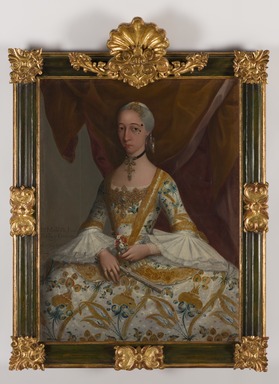Browse

| Accession # | 52.166.4 |
|---|---|
| Artist | Miguel Cabrera |
| Title | Doña María de la Luz Padilla y Gómez de Cervantes |
| Date | ca. 1760 |
| Medium | Oil on canvas |
| Dimensions | 43 x 33 in. (109.2 x 83.8 cm) frame: 57 x 41 x 8 in. (144.8 x 104.1 x 20.3 cm) |
| Inscriptions | Middle left: "D.n Maria d la Lus /Padilla y Cervantes/ Mich.l Cabrera Pinxt" |
| Credit Line | Museum Collection Fund and Dick S. Ramsay Fund |
| Location | American Identities: Art Making / Centennial Era |
| Description | Dona Maria de la Luz Padilla y Cervantes (1732-1789). An oil painting by Miguel Cabrera which shows Dona Maria as a grown young lady. She is the same person as the preceding portrait as an adult. She is shown in a three-quarter view and length in a dress with heavy gold embroidery in a floral pattern against a white background. Her hair is powdered and she has beauty patches on her face. She wears elaborate jewels in her ears, at her neck, and a pectoral, also jewel rings and bracelets. She stands in front of a gold curtain and holds a fan in her right hand and flowers in her left hand. Condition: Good, it has been restored around the edges and on the dress b the Museum Laboratory. |
Curatorial Remarks: Portraits of Pan-American Privilege
These women’s ancestors were among the first European colonizers of the Americas. Some of those colonists crossed the Atlantic to serve the global ambitions of the various crowns of Europe, and others came as economic and religious refugees from Spain, England, and the Dutch Republic. By the eighteenth century, fabulous fortunes had been amassed throughout the region, reflected here in the European-inspired dress and jewelry worn by three privileged Americans.
Miguel Cabrera, eighteenth-century Mexico’s premier painter, portrayed Doña María de la Luz wearing imported silk brocade and five chiqueadores, or glued false beauty spots. Boston’s leading portraitist, John Singleton Copley, painted the monarchist Abigail Pickman Gardiner sporting an uncorseted dress—probably the artist’s invention, since the style was considered inappropriate in New England society but was the height of London fashion. The Hudson Valley portraitist Nehemiah Partridge captured Wyntje Van Vechten’s likeness with more restraint, emphasizing her simple hairstyle, minimal jewelry, and modest dress.